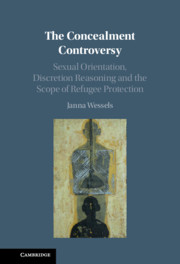 The Concealment Controversy
The Concealment Controversy Theory and Methods
Published online by Cambridge University Press: 19 July 2021
Chapter 2 lays out the theoretical and methodological approach for the analysis. The study draws on discourse analysis, understanding the category of homosexuality to be a construction built on an ‘external dimension’ (a regime of acts) and an ‘internal dimension’ (identity). Queer theory provides insights into the interplay of this act/identity distinction, which functions as an unstable dichotomy where sometimes one is favoured and sometimes the other. Within this system, the gay person is caught in a delicate situation, faced with contradictory expectations as to their ‘discretion’ and disclosure, while at the same time never in full control of what others know about their sexuality. In terms of methodological approach, the analysis is based on discourse analysis on refugee law doctrine. Unlike a classical doctrinal analysis seeking the right legal answer, this study is interested in the ways in which legal doctrine is constructed. Three case studies add an empirical element from the Common European Asylum System: sexuality-based asylum claims from Germany, France and Spain are submitted to analysis.
To save this book to your Kindle, first ensure [email protected] is added to your Approved Personal Document E-mail List under your Personal Document Settings on the Manage Your Content and Devices page of your Amazon account. Then enter the ‘name’ part of your Kindle email address below. Find out more about saving to your Kindle.
Note you can select to save to either the @free.kindle.com or @kindle.com variations. ‘@free.kindle.com’ emails are free but can only be saved to your device when it is connected to wi-fi. ‘@kindle.com’ emails can be delivered even when you are not connected to wi-fi, but note that service fees apply.
Find out more about the Kindle Personal Document Service.
To save content items to your account, please confirm that you agree to abide by our usage policies. If this is the first time you use this feature, you will be asked to authorise Cambridge Core to connect with your account. Find out more about saving content to Dropbox.
To save content items to your account, please confirm that you agree to abide by our usage policies. If this is the first time you use this feature, you will be asked to authorise Cambridge Core to connect with your account. Find out more about saving content to Google Drive.